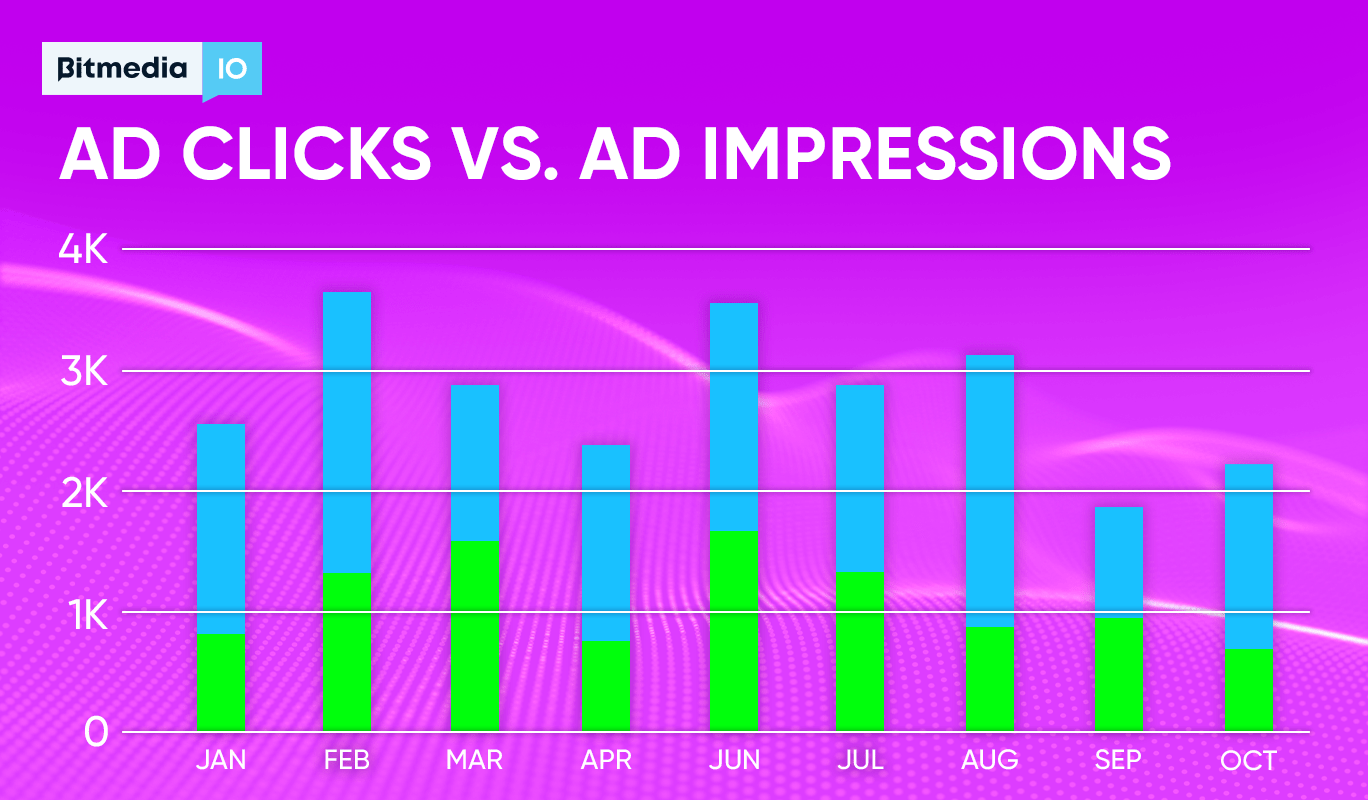Ad Clicks vs Ad Impressions: What’s the Difference?

There’s a big chance you might have come across the word ‘clicks’ or ‘impressions’ in banner advertising, but what do they actually mean?
What is the Importance of Clicks and Impressions in Digital Marketing?
Clicks and impressions are fundamental metrics that help digital marketers gauge the reach and engagement of their banner ads. Let’s explore their significance individually:
Impressions quantify the number of times the banner ad is displayed to users on a website, app, or platform. They showcase ad visibility, and as such, high impression counts are an indication that the ad is being widely seen.
Clicks, on the other hand, quantify the number of times users interact with banner ads by clicking on them. Clicks demonstrate user engagement, which is a measure of a user’s interaction and interest in a banner ad.
What are Impressions in Banner Advertising?
In banner advertising, impressions represent how often a banner ad is displayed on a webpage or app. Impressions are counted whether the user interacts with the ad or not. Impressions are a good way of measuring ad visibility in banner advertising as they provide insight into how often the ad is visible to the target audience.
While it is crucial to focus on achieving a high number of impressions, it is also important to note that they do not measure actual banner advertising engagement.

What are Clicks in a Banner Ad Campaign?
Clicks differ from impressions as they measure actual banner ad engagement. In banner ad campaigns, clicks measure user interactions with an ad. When users click on a banner ad, they are directed to a specific website, landing page, or action. Clicks demonstrate an active response to banner ad campaigns, which can be used to gauge user interest and engagement.
Banner ad campaigns consider clicks to be important metrics that assess the ad’s effectiveness in driving users to take desired actions. Higher click rates suggest successful banner ad campaigns as they demonstrate that the ad is relevant and compelling to the target audience.

Differences between Banner Clicks and Banner Impressions
Now that we’ve discussed the individual meanings of clicks and impressions, let’s explore the differences between the two:
Nature of Interaction
Impressions measure the passive exposure of your banner ads to users while clicks measure active user engagement with your ads through interactions such as clicking.
Objective
You should aim to increase the number of impressions if you intend to showcase your ad’s reach and visibility. Clicks emphasize user engagement and ad effectiveness in prompting target actions.
Conversion Potential
While impressions may not directly lead to conversions, they primarily serve as a visibility metric. Conversely, clicks have a direct impact on conversions. They drive users to take specific actions, such as making a purchase, signing up, or gaining insight into your product or service.
Quality vs. Quantity
A high number of impressions may indicate broad visibility, but it doesn’t guarantee quality engagement. On the other hand, a high number of clicks implies a more engaged audience, but it doesn’t necessarily mean broad visibility.
Optimization Focus
To improve impressions, you need to focus on ad placement, targeting, and reach. To enhance clicks, you must optimize ad content, calls to action, and relevancy to the audience.
Here is a practical example of the difference between clicks and impressions.
An online user starts scrolling through their news feed. As he scrolls, he comes across a sponsored banner ad featuring crypto. This ad is displayed to him based on his online activity and preferences. The user’s seeing the ads without any direct interaction is counted as an impression.
Another user starts scrolling through her feedback, and a cryptocurrency ad captures her attention. She clicks on the ad to learn more about the product and the current promotional offers. This click is a direct interaction with the ad. She is redirected to the website, where she can explore the product in more detail, read customer reviews, and even add it to his cart for potential purchase. In this example, the user’s interactions with the banner ads, in the form of clicks, indicate a higher level of engagement.
Related article: Why the Statistics on Clicks in the Advertising Network Do Not Match with Google Analytics?
Understanding the Role of Clicks and Impressions in Banner Advertising Success
Initial impressions lead to clicks, demonstrating the effectiveness of the ads in capturing users’ interests and encouraging them to take specific actions, whether it’s exploring a product or signing up for a newsletter. This interaction, measured through clicks, is a critical part of the ad campaign’s success.
Both clicks and impressions help in assessing the success of banner ad campaigns. An effective digital marketing campaign requires a balance between the two. While impressions assess visibility, clicks measure active engagement and potential conversions. Understanding the difference between the two will make you better equipped to make data-driven decisions and customize your banner ad campaigns for optimal results.
Bottom Line:
Successful banner ad campaigns should be engaging and interactive enough to elicit responses that prompt users to contact you.
Web terminology can be baffling even for experienced online marketers. We trust this has provided clarity for you. You can get more information about banner ads from our blog.


